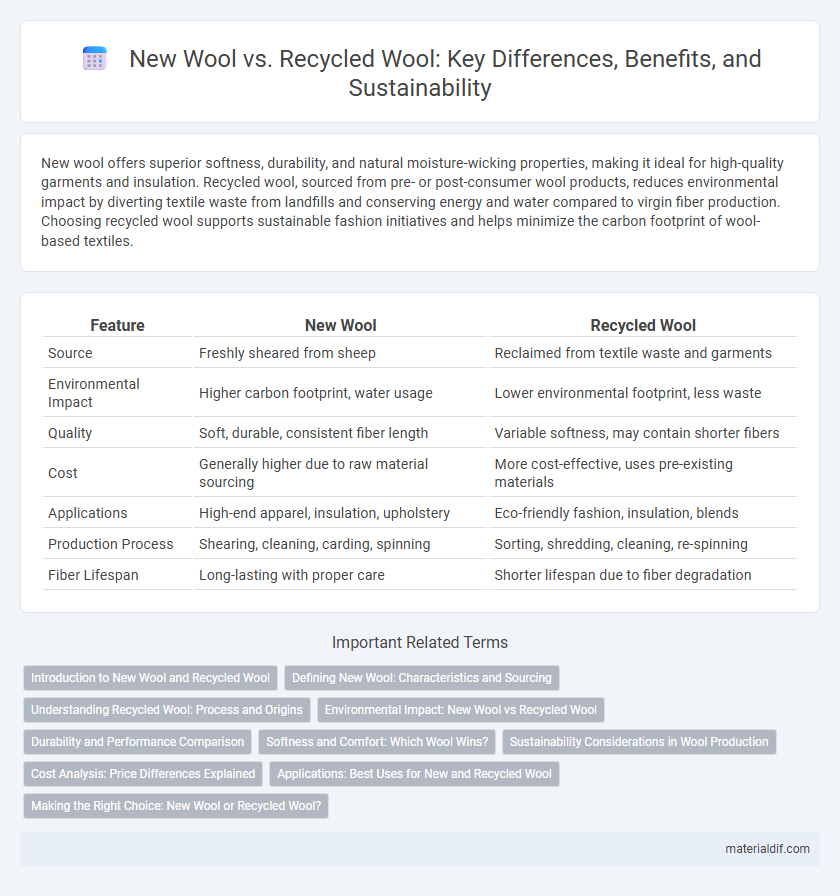New wool offers superior softness, durability, and natural moisture-wicking properties, making it ideal for high-quality garments and insulation. Recycled wool, sourced from pre- or post-consumer wool products, reduces environmental impact by diverting textile waste from landfills and conserving energy and water compared to virgin fiber production. Choosing recycled wool supports sustainable fashion initiatives and helps minimize the carbon footprint of wool-based textiles.
Table of Comparison
| Feature | New Wool | Recycled Wool |
|---|---|---|
| Source | Freshly sheared from sheep | Reclaimed from textile waste and garments |
| Environmental Impact | Higher carbon footprint, water usage | Lower environmental footprint, less waste |
| Quality | Soft, durable, consistent fiber length | Variable softness, may contain shorter fibers |
| Cost | Generally higher due to raw material sourcing | More cost-effective, uses pre-existing materials |
| Applications | High-end apparel, insulation, upholstery | Eco-friendly fashion, insulation, blends |
| Production Process | Shearing, cleaning, carding, spinning | Sorting, shredding, cleaning, re-spinning |
| Fiber Lifespan | Long-lasting with proper care | Shorter lifespan due to fiber degradation |
Introduction to New Wool and Recycled Wool
New wool is harvested directly from sheep, offering superior fiber strength, elasticity, and natural insulation properties essential for high-quality textile production. Recycled wool is made by reclaiming and processing pre-used wool garments or scraps, reducing environmental impact through waste minimization and energy conservation. Both types contribute uniquely to sustainable fashion, with new wool providing premium durability and recycled wool promoting resource efficiency.
Defining New Wool: Characteristics and Sourcing
New wool is sourced directly from sheep shearing, featuring natural fibers that provide superior softness, insulation, and durability compared to recycled options. Its characteristics include high crimp and elasticity, which enhance fabric resilience and moisture-wicking properties. Sustainable sourcing from certified farms ensures new wool maintains traceability and quality standards essential for luxury textiles.
Understanding Recycled Wool: Process and Origins
Recycled wool is produced by collecting post-consumer or post-industrial wool garments and textile scraps, which are then sorted, cleaned, and shredded into fibers before being respun into new yarn. This process reduces waste and the demand for virgin wool, conserving natural resources and minimizing environmental impact. Understanding the origins of recycled wool highlights its role in sustainable fashion by extending the lifecycle of existing materials and promoting circular textile production.
Environmental Impact: New Wool vs Recycled Wool
New wool production requires significant resources, including water, land, and energy, contributing to higher greenhouse gas emissions and habitat disruption. Recycled wool reduces waste by repurposing existing fibers, lowering the demand for raw materials and decreasing carbon footprint. Using recycled wool supports circular fashion practices, minimizing landfill contributions and conserving natural resources.
Durability and Performance Comparison
New wool provides superior durability and natural resilience due to its unprocessed fibers, ensuring better elasticity and shape retention over time. Recycled wool, while eco-friendly, often contains shorter and weaker fibers that can compromise overall strength and reduce performance in high-stress applications. In comparison, new wool delivers higher abrasion resistance and moisture management, making it the preferred choice for long-lasting, high-performance textile products.
Softness and Comfort: Which Wool Wins?
New wool offers superior softness and comfort due to its intact fiber structure, providing natural elasticity and breathability that enhance wearability. Recycled wool, while sustainable and environmentally friendly, often contains shorter fibers that can reduce softness and create a coarser texture. For those prioritizing ultimate comfort and luxury in wool garments, new wool remains the preferred choice.
Sustainability Considerations in Wool Production
New wool offers superior fiber strength and durability compared to recycled wool, which often contains shorter fibers resulting in lower-quality textiles. Sustainability considerations highlight that recycled wool reduces landfill waste and energy consumption, decreasing the overall environmental footprint of wool production. However, new wool relies on responsible sheep farming practices, including managing land use and methane emissions, to ensure ecological balance and sustainable resource use.
Cost Analysis: Price Differences Explained
New wool typically commands a higher price due to raw material sourcing, processing, and quality control factors that ensure durability and purity. Recycled wool offers cost savings by repurposing existing fibers with lower energy consumption and reduced manufacturing expenses, although it may involve additional sorting and cleaning processes. Price differences reflect these production variations, with new wool generally priced 20% to 40% above recycled alternatives in retail markets.
Applications: Best Uses for New and Recycled Wool
New wool excels in high-performance applications such as thermal insulation, luxury fashion garments, and upholstery due to its superior fiber strength, softness, and durability. Recycled wool is ideal for eco-friendly products including felt mats, insulation panels, and sturdy outerwear, benefiting from its reduced environmental impact and adequate resilience. Both types optimize sustainability and performance when matched with applications suited to their fiber qualities and lifecycle considerations.
Making the Right Choice: New Wool or Recycled Wool?
New wool offers superior insulation, durability, and natural moisture-wicking properties, making it ideal for high-performance garments and long-lasting textiles. Recycled wool reduces environmental impact by minimizing waste and energy consumption but may have slightly lower fiber strength and uniformity compared to virgin wool. Choosing between new and recycled wool depends on balancing sustainability goals with performance needs to make an informed, eco-conscious decision.
New Wool vs Recycled Wool Infographic

 materialdif.com
materialdif.com